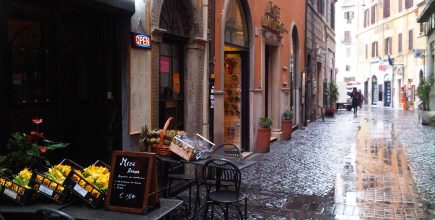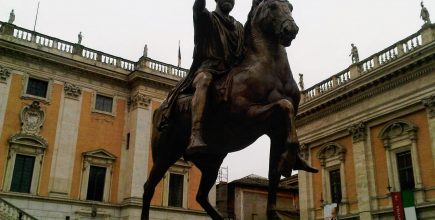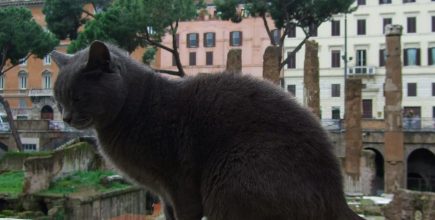City of many faces
2021 is the bicentenary of the death of John Keats in Rome. Externally Keats-Shelley House, on the Spanish Steps, is unchanged from when Keats moved here in vain hopes of a recovery, with so much more to say.
The bicentenary of John Keats death in Rome, 23rd February 2021. (Click here).
Rome, begun by the emperors, finished by Fellini. Once everybody walked there, soldiers from the extremities of the Empire, from Scotland and Syria and deep in Central Europe. Then pilgrims from all parts. Today most of us fly, but flying to Rome is easy. If you want to do something that feels like a journey, think about taking the train there. You can reach Milan or Turin in a single day from London, changing in Paris. Stay overnight, and the next morning there is a high-speed train from Milan to Rome in 2h 55 mins. https://www.seat61.com/Italy.htm
Banner photo of Colosseum: aliantour.com
02 What to see and do
Site seeker
Rome’s great sites, St Peter’s, Piazza Navona, the Forum and Colosseum, Trajan’s Column, Castel Sant’Angelo, the Trevi Fountain, the epic golden statue of Marcus Aurelius, the Pantheon, Piazza del Popolo and the others are so close together that you’ll see them all easily in a weekend’s strolling. And most of them are free. But I always like to see something quite new. This time it was the concentration of treasures in Galleria Borghese, set in the Villa Borghese’s rarified grounds. It’s worth it just for the astonishing Bernini sculpture Daphne and Apollo, and Venus wearing only a rakishly angled hat in Cranach’s Venus and Cupid with a Honeycomb. This is an admirable alternative if the Vatican Treasures is full up. Which it frequently is. Book before your trip.
Movie magic
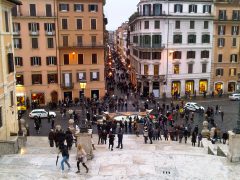
Spanish Steps.
If a stray meteorite ever took out Rome they’d be able to rebuild it, from the big monuments down to the most intimate viale, from the many films shot there. Think Bicycle Thieves through to the BBC’s Zen series, via Federico Fellinii’s La Dolce Vita and many other homages to Rome, summoning up the unchanging essence of the city, even down to the screaming Vespas and straggles of visiting nuns heading for St Peter’s. But the one they would study most closely is Roman Holiday — on our visit the image of Gregory Peck and Audrey Hepburn on a scooter was everywhere. The Talented Mr Ripley is an optional extra for the Spanish Steps.
And dip into Robert Graves’s I Claudius to comprehend the crazy ancient Romans. Then, for a spine-tingling personal connection with Rome, walk through the Forum at 8 am, well before the crowds.
Look for an online Roman Holiday walk, which links up those many familiar film locations down fashionable streets. Most elegant of all is Via Margutta, full of high-end galleries, where the movie’s Joe Bradley (Peck) and the real Fellini lived.
No amount of heaving humanity should put you off the Pantheon. We found a gap in the crowd and burrowed into that vast, 2000 year old open space, as the rain fell gently through the perfect circle in the roof.
Bright star
One of the most poignant places in Rome has nothing to do with imperial grandeur, or centuries of great art and architecture. It’s where a doomed 25 year old lived his last six months. Standing in the room where John Keats died of TB in 1821 was intensely moving, while everyday life continued just outside on the Spanish Steps. Externally Keats-Shelley House is unchanged from when Keats moved here in vain hopes of a recovery, with so much more to say. But his reputation as a great poet was already made (see the movie Bright Star). Everything in this small museum is in English, and there’s an excellent shop. The Landmark Trust rents out the apartment above.
Five minute marvel
There was just time for a hectic dash to the final church on our list, Santa Maria della Vittoria. We had five minutes before leaving for the airport, but I’ll never forget that brief glimpse of a minor marvel of Renaissance Italy. The Ecstasy of Saint Teresa, Bernini’s serene and passionate sculpture in white marble, is one of many masterpieces scattered liberally among the city centre churches.
On the trail of Caravaggio
His powerful paintings, startlingly lit against dark shadow, were the movie posters of the 1600s. The powerful, unorthodox religious paintings by the wild, brilliant Caravaggio, who worked in Rome, featured lowlife models with a story to tell, startlingly–lit against dark shadow. On one visit I tried to track down all eight locations listed in the excellent Rome Purple Guide. Time and quirky Italian opening hours defeated me. But until the next time I will treasure my minutes alone before the drama of the hotheaded genius’s The Conversion of St Paul, in Santa Maria del Popolo, (the apostle is flat on his back, arms outstretched). His St Matthew Trilogy is in San Luigi dei Francesi, close to the Pantheon.
Coffee
Pick of the city centre coffee shops is Tazza d’Oro (next to the Pantheon, with the 24 ft diameter hole in the roof). Cafe Pace (Via della Pace) is where they served TV detective Aurelio Zen his favourite grappa. I vouch for its restorative effect.
Catch the cats
I wrote this entry in 2010. Since then the cats appear to have been seriously culled. I include it for historical interest.
Go off-guidebook and take in some cat-watching around Trajan’s Column. The canine population you see prancing in the fenced-off excavations are pampered by a doting army of elegant ladies, and protected by law. They are an inscrutable link with the city’s past. (There is a similar devotion in Istanbul.)
Kittens frolic on the toes of colossal statues. Streetwise toms head off to sift through choice left-overs outside three star restaurants, and fat tabbies loll like disdainful empresses on the bonnets of Maseratis up quiet side roads.
Pizza prize
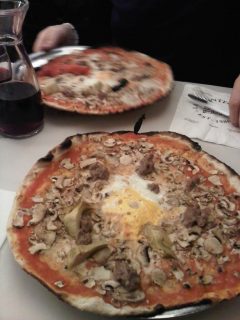
For me one of the joys of visiting Rome is finding my favourite restaurants from way back haven’t changed. Monte Carlo, on Vicolo Savell, just off Piazza Navona, has a few more photos of Carlo with famous customers, but his prices are still stuck deep in the past. Flat-out waiters jink between tight- packed tables serving perfectly simple pizza and pasta, while Carlo, in his trademark blue shirt, presides over his perfect, private empire at a high desk. He wrote our bill neatly out, like a schoolboy’s sum, on the paper tablecloth. www.lamontecarlo.it.
First time we looked, down a deserted Via Santa Maria dei Calderari, Al Pompiere looked permanently shut, with no external hint of any kind of business inside, or that they ever sold food there. Checking again the next night, we found a fairytale revival, all blazing lights and smiling waiters. Trademark dishes include stewed oxtail with celery and tomato. And, from the ancient Roman gourmet Apicius’s recipe book, beef and citron stew.
At Trattoriia da Giggetto (Via del Portico d’Ottavia) they make the fried artichokes and the Filetti di Baccala (cod fritters) just as the Ceccarellis devised it in 1923. In fact you are unlikely to be disappointed in any small family place in Rome.
Rugby Rome
Nobody should need an excuse to visit Rome, but rugby fans have an extra inducement. In the annual Six Nations tournament, Italy play, depending on how the fixtures work out, two or three games there every year in the Stadio Olimpico.
Seasoned followers of the game will have their favourite Six Nation venues. Dublin, perhaps, for the best atmosphere, the warmest hearted fans, and the most fun in the pub. Cardiff, for concentrated passion in a city centre cauldron. Edinburgh for a polite and formal kind of big match occasion (but possibly the most supportive and passionate crowd), just off a distinguished city centre.
Paris is just grand, although the excellent public transport can take away the excitement of arrival. London simply carries on being London; nobody notices the 90,000 gathering, easily absorbed in its south-west suburbs.(Although the walk to the Twickenham stadium from Richmond, across the parks and over the River Thames is one of the best ways to arrive at a major stadium in my opinion.)
But nothing beats Rome – where even the directions are part of the thrill of the city – ‘Metro line A (from Termini train station) to Ottaviano station; then the bus 32 to Piazzale della Farnesina. Or Tram # 2 from Piazzale Flaminio.’ Rugby is just more one more pageant there to add to 2000 years of pageants, in the greatest sporting setting of all. Even though I speak as a rugby diehard, it’s the one city location where, if you arrive at the ground to discover you’ve left your tickets at home, realising you have an extra three or four hours to experience Rome wouldn’t seem such a poor consolation.
03 Where to stay
The Rome Cavalieri is a luxury bolthole, a tranquil hilltop retreat overlooking the city
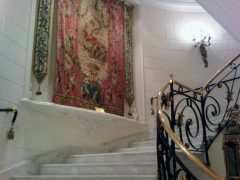
The glory of Rome was spread below us on the eighth floor of the five-star Rome Cavalieri, a tranquil hilltop retreat just west of the Tiber. After planning our day in this luxury bolthole, we sallied forth into the city on the free shuttle bus that runs every hour. Back in the evening for luxury pampering in the spa, a refreshing dip in the choice of pools, or a stroll in the lush hotel gardens. Then dinner in the excellent L’Uliveto restaurant.
But what marks the Cavalieri out from many other top hotels its fine art collection, (and original Rudolf Nureyev costumes). One definition of civilisation is afternoon tea in the lobby, under Tiepolo’s Ulysses discovering Achilles among the daughters of Lycomedes.
I wrote this earlier in 2017.
The Rome Cavalieri is an Italian institution, with a majestic position and illustrious reputation, set in a sweep of private Mediterranean parkland. It has been the lodging of choice for 60 years for royalty, the glitterati and the just plain famous. One of its principal features is one of the most impressive collections of fine art – from Andy Warhol to Tiepolo – you will find on public view in a hotel. The paintings, sculptures and antiques complement the Cavalieri’s other impressive calling card, its three Michelin star restaurant.
The Cavalieri sits high on Monte Mario, with a serene view over some of the greatest of all historical sites, 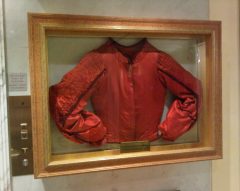 commanded by the Colosseum in the middle distance and St Peters Basilica and the Vatican City close by.
commanded by the Colosseum in the middle distance and St Peters Basilica and the Vatican City close by.
With such a well-founded reputation, there is nothing obvious to improve up. Instead the hotel has recently made what it describe as “enhancements”. The principal feature is the newly-refurbished Imperial Club, where guests in the hotel’s suites may take cocktails, snacks and hors d’oeuvre throughout the day, and enjoy the lavish afternoon tea of cakes and home-made gelato. To set the tone, just outside the club’s entrance is a display of bejewelled costumes that belonged to ballet superstar Rudolf Nureyev.
The hotel’s singular aspects include a floodlit Davis Cup-standard tennis clay court, a 800 m fitness trail within the hotel’s grounds, a state-of-the-art gym, and the offer of a very superior guided walk, to the locations of the recent movie The Great Beauty (La Grande Bellezza), which was set in Rome.
The Cavalieri, the original Waldorf Astoria property in Europe, is one of the most illustrious of Europe’s post-Second World War hotels. It was built in 1963, close to the Via Franciena, the pilgrims’ way from Canterbury, through France, to Rome. It pays homage by putting the word Cavalieri (rider or knight) in its name.
Its opening in 1963 coincided with the height of La Dolce Vita, the city’s golden age of film and the fashion industry. The hotel was designed by a leading architect of the period, Ugo Luccichenti. Its gardens were the work of landscape designer Maria Teresa Parpagliolo, a rare woman celebrity in a male-dominated profession.
The hotel’s La Pergola restaurant, under the direction of chef Heinz Beck since the 1990s has been gathering accolades. Today it is the only hotel in Italy with a three Michelin star restaurant.
It has an enviable reputation in the hotel trade, a place in that exclusive constellation of properties described as simply “one-of-a-kind’. This is further burnished by its art collection. The paintings acquired by the hotel include three works by the 18th Century Venetian master Giovanni Tiepolo, on display in the hotel’s lobby. “Tea with Tiepolo” takes place there every afternoon. Other works on display in the public area include Andy Warhol’s ‘Dollar signs – 1981”.
Other items in the hotel’s 1100 piece collection include 20 rare tapestries, ranging from 16th Century Flemish, to 18th Century Gobelins pieces and, in the Main Lobby, a 1725 Beauvais tapestry.
There are fine pieces in the La Pergola restaurant, and more antiques and contemporary works of art in the hotel’s opulent Petronius Suite, which is also being relaunched this year (2017). Another feature is the Grand Spa Club, offering La Prairie Swiss treatments, and a Turkish bath decorated with Roman mosaics.
Suites are decorated with some splendid pieces of art and furnishings, including original Karl Lagerfeld sofas, 18th-century antiques and Warhol and Robert Indiana paintings.
The hotel’s cinematic tour themed around the film The Great Beauty, is led by resident art historian Alexandra Massini. Stops on the tour include the marble fountain Fontana del Aqua Paolo, which features in the film’s opening scene, Bramante’s Tempietto at San Pietro in Montorio, hidden courtyards, the private palace of Marquis Sacchetti and the Baths of Caracalla.
The hotel provides a regular free shuttle bus down into Rome, and it’s inevitable that patrons would want make the most of one of the world’s great cities. But the Cavalieri expects that, once the sightseeing is done, guests will relish the return to Monte Mario, and will want to spend as much time as possible enjoying the hotel’s rarefied luxury, indulgence and pampering.
04 Nearby
Villa Adriana
If you make just one trip out of town, go to the Villa Adriana at Tivoli (50 minutes by bus) the largest villa in the Roman Empire. The gardens are huge: you need a day.
And to sample Italy‘s unique fusion of sport and fashion try a football game at the Olympic Stadium, home to Roma and Lazio – there are often spare tickets. Dress your best to parade with the smartly coutured throng up the ceremonial Olympic Approach. The ardent fans, the tifosi, won’t bother you. They have their own area, like extras in grand opera. Six Nations rugby internationals are also held here.



